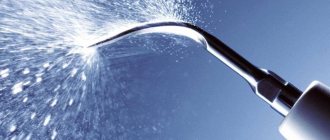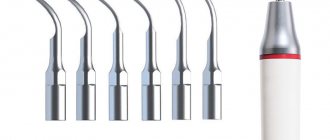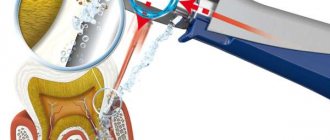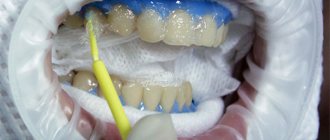Ultrasonic teeth cleaning is one of the safest and most gentle methods of deep teeth cleaning. Even if you systematically and carefully take care of your oral health, over time, plaque, pigmentation and very hard tartar will still form on your teeth, the removal of which is impossible without dental care.
The activity of bacteria causes the appearance of an acidic environment in places where microorganisms accumulate, which leads to bad breath, the formation of caries, bleeding and inflammatory processes of the gums and the active growth of stones that can penetrate into the space under the gums. As a result, the ligamentous apparatus of the tooth is destroyed and periodontal pockets are formed, the teeth become loose and begin to fall out. In addition, the formation of tartar and the growth of pathogenic bacteria in the oral cavity can cause diseases of the gastrointestinal tract, heart and respiratory system. To prevent and treat these problems, professional cleaning methods are used using special devices that do not damage tooth enamel and do not take much time.
How to do professional ultrasonic cleaning
Until about 10-15 years ago, dentists removed hard plaque using curettes. These are hand tools, very sharp and sharpened at the ends. It is clear that the procedure was painful and injured the enamel and gums. The layer of “living” tissue that is removed with curettes is 5-25 microns. This means that each time the enamel becomes thinner and becomes more and more sensitive.
During gentle ultrasonic cleaning, only 0.1 microns of tissue is removed. It is carried out using an ultrasound machine, which is now installed in almost every dentistry and clinic. A special scaler attachment produces silent vibration vibrations with a frequency of 16 - 45 thousand Hz. The doctor adjusts the amplitude of vibrations to remove different types of plaque, including in hard-to-reach places.
Ultrasonic waves eliminate not only visible yellow plaque, but also subgingival bacterial deposits that accumulate in periodontal pockets and trigger the inflammatory process.
Ultrasound, like a drill, crushes tartar into tiny particles. The resulting stone dust is removed using a mouth “vacuum cleaner”, then the enamel is washed with a stream of water. At the very end, the surface of the teeth is ground and polished using professional nylon brushes and abrasive pastes. The entire session lasts about 30-40 minutes. And if there are too many stones, the procedure takes about an hour.
Description of the method
Tartar is nothing more than a hard plaque formed from food debris, dead cells, bacteria and salts, which give it a dark tint, which has a very bad effect on the appearance of the teeth. It is impossible to remove it mechanically due to its density and very strong adherence to the teeth. Chemical cleaning methods are also not always acceptable, since there is a risk of destruction of tooth enamel. The ultrasonic method allows you to remove tartar completely safely, completely cleaning your teeth, including periodontal pockets, and restoring their natural color.
For professional teeth cleaning in a clinic, a special device is used - a scaler that creates ultrasonic waves. In this case, the frequency of their oscillations can be adjusted. The targeted delivery of ultrasonic pulses has a mechanical effect on the stones and destroys them.
Pros and cons of ultrasonic cleaning
The method is excellent for the prevention of caries and inflammatory gum diseases - gingivitis, periodontitis, stomatitis. It is recommended for all patients. This is why ultrasonic teeth cleaning has become so popular and in demand:
- safe removal of tartar without damaging the enamel;
- removal of subgingival plaque, which causes bleeding and inflammation of the gums;
- Ultrasound sterilizes the tooth surface and destroys pathogenic microflora;
- eliminating bad breath;
- lightening the enamel to a natural shade - by 1-2 tones.
Ultrasound or Air Flow: advantages and disadvantages
Ultrasound cleaning takes place without direct contact with the tooth surface, which makes this hygiene method safe for enamel. Ultrasound creates vibration - elastic waves that create vibrations in dental stone, mechanically destroying it. Point exposure allows you to remove even old stones, making the method attractive in advanced cases. Advantages of ultrasound:
- gentle removal of hardened deposits;
- prevention of inflammatory diseases (periodontitis, gingivitis);
- reduction of manifestations of halitosis;
- bleaching to natural enamel color.
The effectiveness of ultrasonic cleaning in destroying hard deposits also has disadvantages: vibrations can destroy solutions that are used to attach crowns or implants. In such cases, preference is given to the more delicate Air Flow. Another feature of ultrasonic cleaning is the potential discomfort of the procedure for sensitive teeth, but this can be easily eliminated with minimal anesthesia.
Cleaning with a mixture of water and Air Flow pressure abrasive gently and thoroughly removes soft deposits on the surface of the tooth and in hard-to-reach areas - fissures and interdental spaces. The procedure does not cause discomfort or pain and does not injure the gums. Obvious advantages of this method:
- cleaning teeth from soft plaque;
- prevention of oral diseases;
- whitening by several tones;
- Possibility of use with orthodontic structures.
Air Flow has practically no disadvantages: these include only the inability to remove subgingival deposits. It will not cure tartar, but there is no such task: a hygienic procedure prevents its appearance.
Care after ultrasonic teeth cleaning
After the procedure, a feeling of freshness and cleanliness appears, the enamel brightens, becomes perfectly smooth, and pleasant to the touch. To maintain the results as long as possible, it is recommended to carefully care for your teeth, brushing them after every meal or at least 2 times a day.
On the first day, slight sensitivity is possible, so it is better to avoid foods that are too cold or hot. It is also recommended to limit the intake of coloring products (coffee, tea, wine) for a couple of days so that the whiteness of the enamel will please you for a long time.
Dentists advise purchasing a new toothbrush. After ultrasound treatment, the gums are slightly irritated and vulnerable to infection. And your old brush can serve as a source of harmful bacteria.
How to make home cleaning as effective as possible?
There are several ways to keep your teeth clean between office appointments.
- Use an ultrasonic brush (if there are no contraindications) or a regular electric brush with a timer. They are effective, but you must remember to change the attachments on time.
- If you use a regular brush, then use a moderately hard brush so that two-minute brushing does not cause bleeding gums.
- Brush your teeth after eating with floss (thread), thereby reducing the accumulation of plaque in the interdental spaces.
- Use a rinse aid with a plaque indicator. It shows how well you brush your teeth.
- Eating more fresh vegetables and fruits acts as a natural cleanser and keeps your gums strong and healthy.
More articles about dental health:
- Aesthetic dentistry: how to correct external defects of teeth
- Wisdom teeth: treat or remove?
Contraindications to ultrasonic teeth cleaning
Although ultrasonic teeth cleaning is recommended for all patients, there are still contraindications:
- cardiac arrhythmia and other serious ailments of the cardiovascular system;
- presence of a pacemaker;
- chronic asthma, bronchitis;
- exacerbation of any respiratory diseases;
- serious infectious diseases - hepatitis, tuberculosis;
- childhood and adolescence.
Unfortunately, ultrasonic cleaning is not suitable for patients who have dental implants and orthopedic structures in the mouth. The fact is that vibrations of ultrasonic waves can disrupt the integrity of some products. This happens extremely rarely, but still not worth the risk. In this case, an alternative method is used - Air Flow abrasive cleaning.
Ultrasound or Air Flow: which is better?
A common mistake is to consider the two types of professional cleaning separately: for better results they are used in combination. Ultrasound removes complex surface contaminants, Air Flow cleans hard-to-reach areas and polishes enamel. After the procedure, it responds well to remineralization, so at the end of professional oral hygiene, the teeth are polished with a brush and coated with fluoride-containing preparations.
To maintain a healthy smile, dentists recommend professional teeth cleanings periodically - once every six months. With regular visits to the doctor and proper hygiene, deposits do not have time to harden and turn into stone. In such cases, the attending physician may suggest doing without ultrasound and limiting yourself to only the Air Flow procedure or creating an individual schedule for sanitation of the oral cavity.
Is it possible to do ultrasonic cleaning at home?
Unfortunately, it is impossible to install a scaler at home and do ultrasonic cleaning of your teeth yourself. This should be done by a specialist. But there is an alternative option - buy an ultrasonic toothbrush. It has a special mechanism and a conductor inside the handle that produce vibrations. This is the so-called “soft ultrasound”, which destroys pathogenic microflora. This device removes plaque 200% more effectively than a regular toothbrush. It’s just that it’s unlikely to be able to cope with massive tartar that has accumulated on your teeth for years. Therefore, it is still recommended to consult a dentist before purchasing.
Contraindications
The use of this technique is excluded in the following cases:
- The patient has a pacemaker that maintains heart rhythm or other stimulants. The range of influence of ultrasound is not limited to the oral cavity. The vibrations created by the device can spread throughout the body and disrupt the rhythm of the stimulators or even completely disable them.
- Increased sensitivity of tooth enamel. Since ultrasonic vibrations not only destroy hard plaque, but are also aimed at externally cleaning bacteria and pigmentation from microscopic enamel pores, this can worsen the situation.
- Pregnancy. Even minor ultrasonic vibrations can lead to disruption of metabolic processes in the body of a pregnant woman, which will negatively affect the child. This circumstance is especially important to take into account in the first three months. At a later date, in the absence of other pathologies, the procedure is allowed.
- Stage of change of bite. Dentists do not recommend ultrasonic teeth cleaning for children because the enamel is too thin, which reaches the required density and thickness two years after the last tooth appears.
- Heart diseases. The result of exposure to ultrasound can be a short-term disturbance in heart rhythm.
- Chronic form of bronchitis or bronchial asthma. Ultrasonic vibrations can lead to a reduction in the lumen of blood vessels and their spasm, which can provoke an attack of suffocation.
- Respiratory tract infections. Since the removal of stones is often associated with injury to the gums, pathogenic microorganisms can enter the soft tissues of the oral cavity and cause complications.
If you are allergic to pain medications, be sure to inform your dentist.
Types and differences of professional teeth cleaning
There are various ways to clean your mouth professionally. Each option has advantages and disadvantages. The choice of technique is made by the dentist.
Ultrasonic
It is performed using a special device - an ultrasonic scaler. The working element of the device is equipped with a nozzle that performs oscillatory movements at an ultrasound frequency of 25-50 kHz. The effect is enhanced by supplying an antiseptic solution or water through the nozzle. Deposits are removed under the influence of cavitation.
This method does not damage the enamel. When treating the oral cavity with an antiseptic, pathogenic bacteria are destroyed. The effectiveness is so high that it is possible to cope even with supra- and subgingival stones. The patient does not feel pain after brushing his teeth.
Laser
Removal of mineral deposits and plaque from the surfaces of the oral cavity is carried out under the influence of a laser beam. The liquid evaporates from them, as a result of which the destruction process begins. Peeled particles are removed with a stream of water supplied under high pressure.
The cost of the service is higher than alternative methods, due to the use of expensive equipment.
Sandblasting
Cleaning is performed using Air Flow equipment. The device even copes with old deposits. The main condition is that the coating must be soft. Air Flow does not remove tartar. The process of sanitation of the mouth involves the use of a special attachment, a mixture containing a fine abrasive, and a fixing gel. This method is used with caution in cases of increased sensitivity of the gums.
Chemical
The essence of the procedure is to apply a special gel containing hydrogen and acid to the teeth. During aging of the product, hard and soft deposits are destroyed under the influence of chemicals.
The method is painless and effective. But the interdental areas are poorly treated.
Mechanical
Sanitation is carried out using brushes and highly active pastes. This method requires more time than alternative options. But the result is high. However, in the process of mechanical impact with brushes, the risk of damage to the enamel increases. For this reason, specialists rarely resort to such cleaning.
How long does the effect of the procedure last and how often should it be performed?
Patients and specialists note that the maximum duration of the effect after ultrasound treatment lasts about a year. The same time is enough to restore the enamel layer. Therefore, after a year the procedure should be carried out again. At the same time, doctors recommend that patients with a tendency to pathological plaque mineralization perform enamel cleansing with ultrasound every 6 months. You can determine the required frequency of dental hygiene yourself. If, immediately after regular daily brushing, your teeth look something like this photo on the left, then the need is ripe and it’s time to make an appointment with the dentist.
Manual teeth cleaning how the procedure is done
Dentists use the manual method as the last stage of a comprehensive hygiene procedure. It helps to manually remove the remains of tartar and plaque in places that are difficult to treat with dental instruments using ultrasound or laser techniques.
Manual hygienic cleaning of teeth is done using strips, curettes or dental floss. These instruments help the dentist eliminate mechanical and hardware processing errors in the space between teeth.
The use of polishing pastes enhances the effect.
Oral care after ultrasonic cleaning
Dentists recommend adhering to the following tips:
- In the first 3–4 days after the procedure, teeth should be brushed after each meal and at night. In this case, you should not use abrasive toothpastes, as this can irreversibly damage the enamel layer. You should also change the old brush, as pathogenic bacteria remain on it, and the enamel is overly vulnerable during this period;
- reduce in your diet foods and drinks containing natural and artificial colors (tea, coffee, berries, etc.). This rule should be followed at least in the first week after the procedure;
- increase the number of foods that are sources of calcium in the menu;
- avoid sudden temperature changes, for example, after hot tea you should not eat ice cream;
- in case of possible injury to the mucous membrane of the gums, they should be treated with antiseptic healing ointments, rinsed with a warm chamomile decoction;
- If inflammation occurs, consult your doctor immediately.
The dental network offers ultrasonic teeth cleaning services. Our clinic offers family and savings discounts. Our doctors are highly qualified and continue to improve their skills in leading Russian and European dental clinics. The level of our medical services meets international standards.
Branches of our orthodontic center are located in Moscow within walking distance from the metro:
- Art. Alekseevskaya (VDNKh district, etc. Mira), address: st. 3rd Mytishchiskaya house 3, building 2;
- Art. Shelepikha, address: Shelepikhinskaya embankment, address: building 34, building 1.
We will help keep your teeth healthy! We are waiting for you in our clinic every day without breaks and weekends.
Stages of the procedure
Professional sanitation of the oral cavity is carried out in stages.
Stage 1: Comprehensive inspection
It is performed using modern instruments to identify deposits and assess the condition of tissues.
Stage 2: removal of soft and hard formations
To obtain high results, two methods are combined: ultrasonic cleaning and Air Flow. The first option destroys the structure of tartar, the second removes plaque and remaining stone.
Stage 3: Polishing
The enamel is polished using special brushes and paste. The surface is smooth and shiny.
Stage 4: fluoridation
To protect bone tissue, a gel or varnish containing a high concentration of fluoride is used.
How do children brush their teeth?
Ultrasonic cleaning and Air Flow are not prescribed for children under 14 years of age. Professional sanitation of the oral cavity is performed using special brushes and paste. After dental treatment, the surface is coated with fluoride-containing gel to strengthen the enamel.










